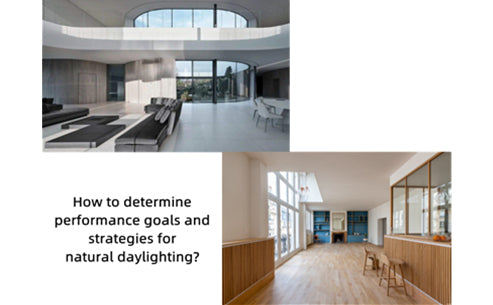
Main content:
1. Determining performance goals for natural lighting

The performance goals for natural lighting are primarily to save lighting energy costs and improve visual quality. Designers should improve visual quality and avoid artificial lighting as much as possible based on illuminance levels that meet the needs of users and lighting goals.
(1) Lighting standards. The quantity evaluation index of daylighting standard is expressed by daylighting coefficient C. Because the outdoor natural light is affected by various meteorological conditions, the changes in a day are great, thus affecting the change of indoor light, so an absolute value cannot be used to measure the indoor lighting effect. It is more appropriate to use the relative value of the daylighting coefficient to evaluate the lighting effect. The light and climate in China are quite different. For example, the annual average of outdoor total illuminance in the vast plateau area in the northwest is as high as 31.46klx, while that in the Sichuan Basin and the northeastern area is only 21.18klx, a difference of as high as 50%. It is obviously unreasonable to use the same standard in the lighting design. Therefore, in the lighting design standard, China is divided into five light and climate zones and the corresponding lighting design standards are adopted respectively.
(2) Improve visual quality. The general goal of natural lighting is to provide adequate, high-quality light. At the same time, try to avoid direct glare and excessive brightness ratio.
① Reduce the illuminance gradient: Due to the limitation of the window position and the change of natural light, the natural light illumination inside the building is often uneven. There is too little light in the place far from the window, and too much light in the place close to the window. Therefore, it is necessary to introduce more light into the deeper parts of the room, which is not only to improve the illuminance there, but also to reduce the illuminance gradient in the room.
② Avoid direct glare: Direct glare is likely to occur when the light enters the room directly from windows and skylights without any shading. This glare is made even more dazzling if the walls near the window are not illuminated and thus appear rather dark.
③ Eliminate excessive brightness ratios: If sunlight casts mottled light and shadows on some work areas, it will cause many unbearable brightness ratios. Therefore, it should be eliminated as much as possible.
2. Identify basic strategies for natural lighting

Natural lighting is closely related to many factors. A building's site analysis, plan and space layout, and lighting orientation are all critical to a successful natural lighting design. Consider not only the exterior form of the building, but also the layout of its interior spaces. Internal dividers, unless made of glass, hinder the penetration of natural light. Only after these basic matters have been determined, can the arrangement and design of the windows begin.
(1) Site analysis. Before determining the orientation of the building and natural lighting techniques, it is important to determine how natural light will enter. The designer must first determine which activities require direct natural light and which require indirect natural light. To ensure sun exposure at the right time of day or year, designers must establish design guidelines that distinguish when and where sunlight or natural light is needed. This information can then be used to assess existing site conditions and determine design approaches to gain solar illumination. For example, buildings or trees near the site may affect natural lighting, and the analysis of the incident angle can determine the reasonable position of the building on the site to ensure sufficient natural lighting.
Since natural lighting and sunshine are closely related, for residential buildings (including hospital ward buildings, convalescent buildings, kindergartens, nurseries, teaching buildings of primary and secondary schools, etc.), relevant sunshine requirements should also be considered.
(2) Plane and space layout. The floor plan of the building determines not only the possible mix of vertical and horizontal windows, but also the amount of natural light for the interior areas. Usually in a multi-storey building, the area with a depth of <5m in the window can be fully illuminated by natural lighting, the area with a depth of 5~10m can be partially illuminated, and the area with a depth of >10m cannot use natural lighting at all. The building plans of the three layouts listed in Figure 1 have the same area (both 900m2). In the square layout, 16% of the area has no natural light at all, and another 33% has only partial access; in the rectangular layout, there is no place where natural lighting is completely blocked, but there is still a considerable area that can only partially get natural lighting; while the layout with a central patio allows all areas in the building to fully receive natural lighting. Therefore, the depth of the building should be reduced as much as possible; if the depth of one side is > 10m, the patio should be set up as much as possible.

The interior space layout has a great influence on natural lighting. Open space layout or transparent partitions are very beneficial for natural light to enter the interior of the building. For example, the use of glass partitions can create a personal space that isolates sound without blocking light; if you also need to create a personal space that blocks vision, you can cover the glass with curtains or movable blinds, or use translucent materials, or you can choose to install glass only where the partition is above eye level (see Figure 2) .

Figure 2 - Glass partitions allow natural light to penetrate deep into the interior
(3) Lighting orientation. Since the height and orientation of the sun varies with the season and time of day, the building must be properly oriented to maximize daylighting potential and avoid excessive solar radiation and glare.
The best direction for natural lighting is north, because the light from this direction is relatively stable. Although the amount of light coming from the north is lower, the quality is higher. And this direction also rarely encounters glare problems caused by direct sunlight. Especially in hot weather areas, south-facing windows often require the addition of sun-controlling architectural components (such as sun visors) due to excessive heat from direct sunlight, so north-facing is more appropriate.
A south-facing orientation is also a better direction for natural lighting. The south-facing part of the building gets the most sunlight, both on a daily basis and in a year. This extra sunlight provides more daylight than northerly facing in winter and in rainy weather. In addition, in severe cold and cold regions, the greenhouse effect created by south-facing windows can provide additional heat to partially meet the heating needs, so south-facing is more suitable.
The most unfavorable directions are east and west. When the sun is in the east or west, it is lower in the sky. Therefore, it will bring very serious problems such as glare and shadow shading. In addition, these two directions have the highest intensity of sunlight, which will bring excessive heat to the building in summer, resulting in an increase in the cooling load of air conditioners.
















